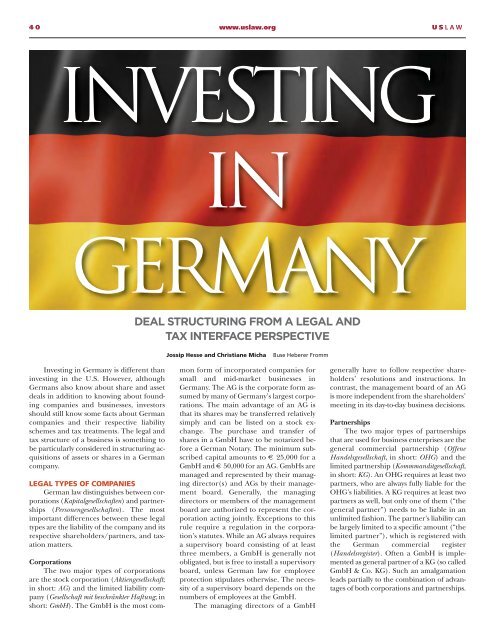CYBER BREACH FALLOUT
2015_Fall_Winter_USLAW-Magazine
2015_Fall_Winter_USLAW-Magazine
You also want an ePaper? Increase the reach of your titles
YUMPU automatically turns print PDFs into web optimized ePapers that Google loves.
4 0 www.uslaw.org U S LAW<br />
Investing<br />
In<br />
Germany<br />
DEAL STRUCTURING FROM A LEGAL AND<br />
TAX INTERFACE PERSPECTIVE<br />
Jossip Hesse and Christiane Micha<br />
Buse Heberer Fromm<br />
Investing in Germany is different than<br />
investing in the U.S. However, although<br />
Germans also know about share and asset<br />
deals in addition to knowing about founding<br />
companies and businesses, investors<br />
should still know some facts about German<br />
companies and their respective liability<br />
schemes and tax treatments. The legal and<br />
tax structure of a business is something to<br />
be particularly considered in structuring acquisitions<br />
of assets or shares in a German<br />
company.<br />
LEGAL TYPES OF COMPANIES<br />
German law distinguishes between corporations<br />
(Kapitalgesellschaften) and partnerships<br />
(Personengesellschaften). The most<br />
important differences between these legal<br />
types are the liability of the company and its<br />
respective shareholders/partners, and taxation<br />
matters.<br />
Corporations<br />
The two major types of corporations<br />
are the stock corporation (Aktiengesellschaft;<br />
in short: AG) and the limited liability company<br />
(Gesellschaft mit beschränkter Haftung; in<br />
short: GmbH). The GmbH is the most common<br />
form of incorporated companies for<br />
small and mid-market businesses in<br />
Germany. The AG is the corporate form assumed<br />
by many of Germany’s largest corporations.<br />
The main advantage of an AG is<br />
that its shares may be transferred relatively<br />
simply and can be listed on a stock exchange.<br />
The purchase and transfer of<br />
shares in a GmbH have to be notarized before<br />
a German Notary. The minimum subscribed<br />
capital amounts to € 25,000 for a<br />
GmbH and € 50,000 for an AG. GmbHs are<br />
managed and represented by their managing<br />
director(s) and AGs by their management<br />
board. Generally, the managing<br />
directors or members of the management<br />
board are authorized to represent the corporation<br />
acting jointly. Exceptions to this<br />
rule require a regulation in the corporation’s<br />
statutes. While an AG always requires<br />
a supervisory board consisting of at least<br />
three members, a GmbH is generally not<br />
obligated, but is free to install a supervisory<br />
board, unless German law for employee<br />
protection stipulates otherwise. The necessity<br />
of a supervisory board depends on the<br />
numbers of employees at the GmbH.<br />
The managing directors of a GmbH<br />
generally have to follow respective shareholders’<br />
resolutions and instructions. In<br />
contrast, the management board of an AG<br />
is more independent from the shareholders’<br />
meeting in its day-to-day business decisions.<br />
Partnerships<br />
The two major types of partnerships<br />
that are used for business enterprises are the<br />
general commercial partnership (Offene<br />
Handelsgesellschaft, in short: OHG) and the<br />
limited partnership (Kommmanditgesellschaft,<br />
in short: KG). An OHG requires at least two<br />
partners, who are always fully liable for the<br />
OHG’s liabilities. A KG requires at least two<br />
partners as well, but only one of them (“the<br />
general partner”) needs to be liable in an<br />
unlimited fashion. The partner’s liability can<br />
be largely limited to a specific amount (“the<br />
limited partner”), which is registered with<br />
the German commercial register<br />
(Handelsregister). Often a GmbH is implemented<br />
as general partner of a KG (so called<br />
GmbH & Co. KG). Such an amalgamation<br />
leads partially to the combination of advantages<br />
of both corporations and partnerships.


